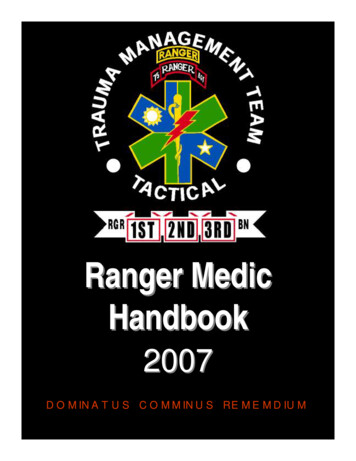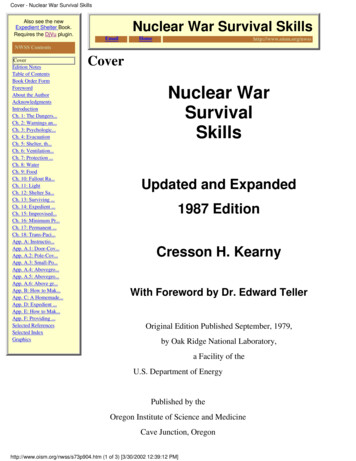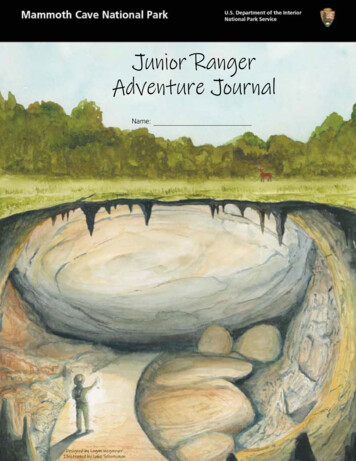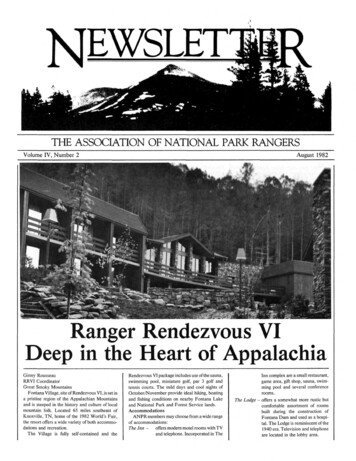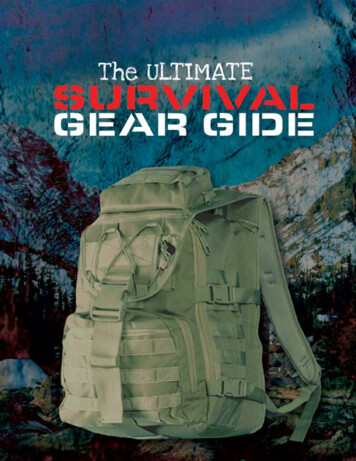
Transcription
SH 21-76UNITED STATES ARMYRANGER HANDBOOKNot for the weakor faintheartedRANGER TRAINING BRIGADEUNITED STATES ARMY INFANTRY SCHOOLFORT BENNING, GEORGIAJULY 2006
RANGER CREEDRecognizing that I volunteered as a Ranger, fully knowing the hazards of my chosen profession, I will always endeavor touphold the prestige, honor, and high esprit de corps of the Rangers.Acknowledging the fact that a Ranger is a more elite Soldier who arrives at the cutting edge of battle by land, sea, or air, Iaccept the fact that as a Ranger my country expects me to move further, faster, and fight harder than any other soldier.Never shall I fail my comrades I will always keep myself mentally alert, physically strong, and morally straight and I willshoulder more than my share of the task whatever it may be, one hundred percent and then some.Gallantly will I show the world that I am a specially selected and well trained Soldier. My courtesy to superior officers,neatness of dress, and care of equipment shall set the example for others to follow.Energetically will I meet the enemies of my country. I shall defeat them on the field of battle for I am better trained and willfight with all my might. Surrender is not a Ranger word. I will never leave a fallen comrade to fall into the hands of the enemyand under no circumstances will I ever embarrass my country.Readily will I display the intestinal fortitude required to fight on to the Ranger objective and complete the mission, though Ibe the lone survivor.STANDING ORDERS, ROGERS' RANGERS1. Don't forget nothing.2. Have your musket clean as a whistle, hatchet scoured, sixty rounds powder and ball, and be ready to march at a minute'swarning.3. When you're on the march, act the way you would if you was sneaking up on a deer. See the enemy first.4. Tell the truth about what you see and what you do. There is an army depending on us for correct information. You can lieall you please when you tell other folks about the Rangers, but don't never lie to a Ranger or officer.5. Don't never take a chance you don't have to.6. When we're on the march we march single file, far enough apart so one shot can't go through two men.7. If we strike swamps, or soft ground, we spread out abreast, so it's hard to track us.8. When we march, we keep moving till dark, so as to give the enemy the least possible chance at us.9. When we camp, half the party stays awake while the other half sleeps.10. If we take prisoners, we keep' em separate till we have had time to examine them, so they can't cook up a storybetween' em.11. Don't ever march home the same way. Take a different route so you won't be ambushed.12. No matter whether we travel in big parties or little ones, each party has to keep a scout 20 yards ahead, 20 yards on eachflank, and 20 yards in the rear so the main body can't be surprised and wiped out.13. Every night you'll be told where to meet if surrounded by a superior force.14. Don't sit down to eat without posting sentries.15. Don't sleep beyond dawn. Dawn's when the French and Indians attack.16. Don't cross a river by a regular ford.17. If somebody's trailing you, make a circle, come back onto your own tracks, and ambush the folks that aim to ambush you.18. Don't stand up when the enemy's coming against you. Kneel down, lie down, hide behind a tree.19. Let the enemy come till he's almost close enough to touch, then let him have it and jump out and finish him up withyour hatchet.--MAJOR ROBERT ROGERS, 1759i
RANGER HISTORYThe history of the American Ranger is a long and colorful saga of courage, daring and outstanding leadership. It is a story ofmen whose skills in the art of fighting have seldom been surpassed. Only the highlights of their numerous exploits are told here.Rangers primarily performed defensive missions until Benjamin Church’s Company of Independent Rangers from PlymouthColony proved successful in raiding hostile Indians during King Phillip’s War in 1675. In 1756, Major Robert Rogers, a native ofNew Hampshire, recruited nine companies of American colonists to fight for the British during the French and Indian War.Ranger techniques and methods of operation were an inherent characteristic of the American frontiersmen; however, MajorRogers was the first to capitalize on them and incorporate them into the fighting doctrine of a permanently organizedfighting force.The method of fighting used by the first Rangers was further developed during the Revolutionary War by Colonel DanielMorgan, who organized a unit known as “Morgan’s Riflemen”. According to General Burgoyne, Morgan’s men were “ .the mostfamous corps of the Continental Army, all of them crack shots.”Francis Marion, the “Swamp Fox,” organized another famous Revolutionary War Ranger element known as “Marion’sPartisans.” Marion’s Partisans, numbering anywhere from a handful to several hundred, operated both with and independent ofother elements of General Washington’s Army. Operating out of the Carolina swamps, they disrupted British communicationsand prevented the organization of loyalists to support the British cause, substantially contributing to the American victory.The American Civil War was again the occasion for the creation of special units such as Rangers. John S. Mosby, a masterof the prompt and skillful use of cavalry, was one of the most outstanding Confederate Rangers. He believed that by resorting toaggressive action he could compel his enemies to guard a hundred points. He would then attack one of the weakest points andbe assured numerical superiority.With America’s entry into the Second World War, Rangers came forth to add to the pages of history. Major William O. Darbyorganized and activated the 1st Ranger Battalion on June19, 1942 at Carrickfergus, North Ireland. The members were all handpicked volunteers; 50 participated in the gallant Dieppe Raid on the northern coast of France with British and Canadiancommandos. The 1st, 3rd, and 4th Ranger Battalions participated with distinction in the North African, Sicilian and Italiancampaigns. Darby’s Ranger Battalions spearheaded the Seventh Army landing at Gela and Licata during the Sicilian invasionand played a key role in the subsequent campaign which culminated in the capture of Messina. They infiltrated German linesand mounted an attack against Cisterna, where they virtually annihilated an entire German parachute regiment during close in,night, bayonet, and hand-to-hand fighting.The 2nd and 5th Ranger Battalions participated in the D-Day landings at Omaha Beach, Normandy. It was during the bitterfighting along the beach that the Rangers gained their official motto. As the situation became critical on Omaha Beach, thedivision commander of the 29th Infantry Division stated that the entire force must clear the beach and advance inland. He thenturned to Lieutenant Colonel Max Schneider, Commander of the 5th Ranger Battalion, and said, “Rangers, lead the way.” The 5thRanger Battalion spearheaded the breakthrough and thus enabled the allies to drive inland away from the invasion beaches.The 6th Ranger Battalion, operating in the Pacific, conducted Ranger type missions behind enemy lines which involvedreconnaissance and hard-hitting, long-range raids. They were the first American contingent to return to the Philippines,destroying key coastal installations prior to the invasion. A reinforced company from the 6th Ranger Battalion formed the rescueforce which liberated American and allied prisoners of war from the Japanese prison camp at Cabanatuan.Another Ranger-type unit was the 5307th Composite Unit (Provisional), organized and trained as a long-range penetrationunit for employment behind enemy lines in Japanese occupied Burma. The unit commander was Brigadier General (later MajorGeneral) Frank D. Merrill. Its 2,997 officers and men became popularly known as “Merrill’s Marauders.”The men composing Merrill’s Marauders were volunteers from the 5th, 154th, and 33rd Infantry Regiments and from otherInfantry regiments engaged in combat in the southwest and South Pacific. These men responded to a call from then Chief ofStaff, General George C. Marshall, for volunteers for a hazardous mission. These volunteers were to have a high state ofphysical ruggedness and stamina and were to come from jungle-trained and jungle-tested units.Prior to their entry into the Northern Burma Campaign, Merrill’s Marauders trained in India under the overall supervision ofMajor General Orde C. Wingate, British Army. There, they were trained from February to June 1943 in long-range penetrationtactics and techniques of the type developed and first employed by General Wingate. The operations of the Marauders were
closely coordinated with those of the Chinese 22nd and 38th Divisions in a drive to recover northern Burma and clear the way forthe construction of Ledo Road, which was to link the Indian railhead at Ledo with the old Burma Road to China. The Maraudersmarched and fought through jungle and over mountains from Hukwang Valley in northwest Burma to Myitkyina and theIrrawaddy River. In 5 major and 30 minor engagements, they met and defeated the veteran soldiers of the Japanese 18thDivision. Operating in the rear of the main force of the Japanese, they prepared the way for the southward advances of theChinese by disorganizing supply lines and communications. The climax of the Marauder’s operations was the capture ofMyitkyina Airfield, the only all-weather strip in northern Burma. This was the final victory of “Merrill’s Marauders,” whichdisbanded in August 1944. Remaining personnel were consolidated into the 475th Infantry Regiment, which fought its last battleon February 3, and 4,1945, at Loi-Kang Ridge, China. This Infantry Regiment would serve as the forefather of today’s 75thRanger Regiment.Shortly after the outbreak of the Korean War in June 1950, the 8th Army Ranger Company was formed of volunteers fromAmerican units in Japan. The Company was trained in Korea and distinguished itself in combat during the drive to the YaluRiver, performing task force and spearhead operations. In November 1950 during the massive Chinese intervention, this smallunit, though vastly outnumbered, withstood five enemy assaults on its position.In September 1950, a Department of the Army message called for volunteers to be trained as Airborne Rangers. In the 82ndAirborne Division, five thousand regular Army paratroopers volunteered, and from that number nine hundred men were selectedto form the initial eight Airborne Ranger Companies. An additional nine companies were formed from volunteers of regular Armyand National Guard Infantry Divisions. These seventeen Airborne Ranger companies were activated and trained at Fort Benning,Georgia, with most receiving additional training in the mountains of Colorado.In 1950 and 1951, some 700 men of the 1st, 2nd, 3rd, 4th, 5th, and 8th Airborne Ranger companies fought to the front of everyAmerican Infantry Division in Korea. Attacking by land, water, and air, these six Ranger companies conducted raids, deeppenetrations, and ambush operations against North Korean and Chinese forces. They were the first Rangers in history to make acombat jump. After the Chinese intervention, these Rangers were the first Americans to re-cross the 38th parallel. The 2ndAirborne Ranger Company was the only African American Ranger unit in the history of the American Army. The men of the sixRanger companies who fought in Korea paid the bloody price of freedom. One in nine of this gallant brotherhood died on thebattlefields of Korea.Other Airborne Ranger companies led the way while serving with infantry divisions in the United States, Germany, andJapan. Men of these companies volunteered and fought as members of line infantry units in Korea. One Ranger, Donn Porter,would be posthumously awarded the Medal of Honor. Fourteen Korean War Rangers became general officers and dozensbecame colonels, senior noncommissioned officers, and leaders in civilian life. They volunteered for the Army, the Airborne, theRangers, and for combat. The first men to earn and wear the coveted Ranger Tab, these men are the original Airborne Rangers.In October 1951, the Army Chief of Staff, General J. Lawton Collins directed, “Ranger training be extended to all combatunits in the Army.” The Commandant of the Infantry School was directed to establish a Ranger Department. This newdepartment would develop and conduct a Ranger course of instruction. The objective was to raise the standard of training in allcombat units. This program was built upon what had been learned from the Ranger Battalions of World War II and the AirborneRanger companies of the Korean conflict.During the Vietnam Conflict, fourteen Ranger companies consisting of highly motivated volunteers served with distinctionfrom the Mekong Delta to the DMZ. Assigned to separate brigade, division, and field force units, they conducted long-rangereconnaissance and exploitation operations into enemy-held areas providing valuable combat intelligence. Initially designated atLRRP, then LRP companies, these units were later designated as C, D,E,F,G,H,I,K,L,M,N,O and P (Ranger) 75th Infantry.Following Vietnam, recognizing the need for a highly trained and highly mobile reaction force, the Army Chief of Staff,General Abrams directed the activation of the first battalion-sized Ranger units since World War II, the 1st and 2nd Battalions(Ranger), 75th Infantry. The 1st Battalion was trained at Fort Benning, Georgia and was activated February 8, 1974 at FortStewart, Georgia with the 2nd Battalion being activated on October 3, 1974. The 1st Battalion is now located at Hunter ArmyAirfield, Georgia and the 2nd Battalion at Fort Lewis, Washington.The farsightedness of General Abrams’ decision, as well as the combat effectiveness of the Ranger battalions, was provenduring the United States’ invasion of the island of Grenada in October 1983 to protect American citizens there, and to restoredemocracy. As expected, Rangers led the way! During this operation, code named “Urgent Fury,” the Ranger battalionsiii
conducted a daring, low level airborne assault (from 500 feet) to seize the airfield at Point Salines, and then continuedoperations for several days to eliminate pockets of resistance, and rescue American medical students.As a result of the demonstrated effectiveness of the Ranger battalions, the Department of the Army announced in 1984 that itwas increasing the strength of Ranger units to its highest level in 40 years. To do this, it activated another Ranger battalionas well as a Ranger Regimental Headquarters. These new units, the 3rd Battalion (Ranger), 75th Infantry, and HeadquartersCompany (Ranger), 75th Infantry, have increased the Ranger strength of the Army to over 2,000 soldiers actually assigned toRanger units. On February 3, 1986, the 75th Infantry was renamed the 75th Ranger Regiment.On December 20, 1989, the 75th Ranger Regiment was once again called upon to demonstrate its effectiveness in combat.For the first time since its reorganization in 1984, the Regimental Headquarters and all three Ranger battalions were deployedon Operation “Just Cause” in Panama. During this operation, the 75th Ranger Regiment spearheaded the assault into Panamaby conducting airborne assaults onto Torrijos/Tocumen Airport and Rio Hato Airfield to facilitate the restoration of democracy inPanama, and protect the lives of American citizens. Between December 20, 1989 and January 7, 1990, numerous follow-onmissions were performed in Panama by the Regiment.Early in 1991, elements of the 75th Ranger Regiment deployed to Saudi Arabia in support of Operation Desert Storm.In August 1993, elements of the 75th Ranger Regiment deployed to Somalia in support of Operation Restore Hope, andreturned November 1993.In 1994, elements of the 75th Ranger Regiment deployed to Haiti in support of Operation Uphold Democracy.In 2000 – 2001, elements of the 75th Ranger Regiment deployed to Kosovo in support of Operation Joint Guardian.Since September 11, 2001, the 75th Ranger Regiment has led the way in the Global War on Terrorism. In October 2001,elements of the 75th Ranger Regiment deployed to Afghanistan in support of Operation Enduring Freedom. In March 2003,elements of the Regiment deployed in support of Operation Iraqi Freedom.The performance of these Rangers significantly contributed to the overall success of these operations and upheld theRanger tradition of the past. As in the past, the Regiment stands ready to execute its mission to conduct special operations insupport of the United States’ policies and objectives.RANGER MEDAL OF HONOR WINNERSMillett, Lewis L. Sr.Porter, Donn F.*.Mize, Ola L. .Dolby, David C.Foley, Robert F. .Zabitosky, Fred M. .Bucha, Paul W. .Rabel, Laszlo*.Howard, Robert L.Law, Robert D. *.Kerrey, J. Robert.Doane, Stephen H.* .Pruden, Robert J.* .Littrell, Gary L. .Lucas, Andre C.*.Gordon, Gary I. *.Shughart, Randall D. * .*Awarded posthumouslyCaptain.Sergeant.Sergeant.Staff Sergeant .Captain.Staff Sergeant .Captain.Staff Sergeant .Sergeant First Class .Specialist 4.Lieutenant.1st Lieutenant.Staff Sergeant .Sergeant First Class .Lt Colonel .Master Sergeant.Sergeant First Class .Feb 7 1951 .Sept 7 1952 .June 10-11 1953.May 21 1966.Nov 5 1966 .Feb 19 1968 .May 16-19 1968.Nov 13 1968 .Dec 30 1968 .Feb 22 1969 .Mar 14 1969 .Mar 25 1969 .Nov 22 1969 .April 4-8 1970 .Jul 1-23 1970.Oct 3 1993.Oct 3 1993.Co. E 2/27th InfantryCo. G 2/14th InfantryCo. K 3/15th InfantryCo. B 1/8th (ABN) CalvaryCo. A 2/27th Infantry5th Special ForcesCo. D 3/187 Infantry74th Infantry (LRRP)5th Special ForcesCo. I 75th Infantry (Ranger)Seal Team 1Co. B 1/5th InfantryCo. G 75th Infantry (Ranger)Advisory Team 21 (Ranger)HHC 2/506 InfantryTask Force RangerTask Force Ranger
SUMMARY OF CHANGESTHROUGHOUT .UPDATED doctrine, technology, terms; clarified verbiageCHAPTER 1 .UPDATED duties and responsibilitiesADDED FOCHAPTER 2 .UPDATED WARNOADDED sample WARNOUPDATED OPORDADDED terrain modelCHAPTER 3 .ADDED PLOT-CRADDED risk estimate distancesCHAPTER 4 .IDENTIFIED TL positions during movementCHAPTER 5 .REORGANIZED combat operationsCHAPTER 6 .UPDATED battle drills IAW FM 3-21.8CONSOLIDATED building clearing techniques under Battle Drill 5(previously in Chapter 14)CHAPTER 7 .ADDED section on antennasCHAPTER 8 .UPDATED aircraftCHAPTER 9 .UPDATED rope bridge equipmentUPDATED sequence and responsibilitiesCHAPTER 10 .UPDATED equipment and descriptionsUPDATED climbing commandsCHAPTER 11 .NACHAPTER 12 .ADDED first aid techniquesCHAPTER 13 .ADDED figure ‘Lighting a time fuse with a match’ADDED expedient explosivesADDED table of US demolitionsADDED breaching and timber cutting chargesCHAPTER 14 .MOVED building clearing techniques to Battle Drill 5 in Chapter 6ADDED marking SOPCHAPTER 15 .NEW chapter covering vehicle convoy operationsAPPENDIX A.NEW - ResourcesAPPENDIX B.NEW - Quick Reference Cardsv
TABLE OF CONTENTSRANGER CREED . iSTANDING ORDERS ROGER’S RANGERS. iRANGER HISTORY. ii.CHAPTER 1 – LEADERSHIP1-1.PRINCIPLES .1-11-2.DUTIES, RESPONSIBILITIES, AND ACTIONS .1-21-3.ASSUMPTION OF COMMAND .1-7.CHAPTER 2 – OPERATIONS2-1.TROOP-LEADING PROCEDURES.2-12-2.COMBAT INTELLIGENCE .2-52-3.WARNING ORDER .2-62-4.OPERATIONS ORDER .2-152-5.FRAGMENTARY ORDER .2-222-6.ANNEXES .2-292-7.COORDINATION CHECKLISTS .2-352-8.DOCTRINAL TERMS .2-402-9.TERRAIN MODEL .2-43.CHAPTER 3 – FIRE SUPPORT3-1.PLANNING .3-13-2.TASKS.3-13-3.CAPABILITIES .3-23-4.RISK ESTIMATE DISTANCES.3-23-5.TARGET OVERLAYS.3-33-6.CLOSE AIR SUPPORT .3-43-7.CALL FOR FIRE.3-5CHAPTER 4 – MOVEMENT4-1.TECHNIQUES.4-14-2.TACTICAL MARCHES .4-44-3.MOVEMENT IN LIMITED VISIBILITY CONDITIONS .4-64-4.DANGER AREAS .4-7CHAPTER 5 – PATROLS5-1.PRINCIPLES .5-15-2.PLANNING .5-15-3.RECONNAISSANCE PATROLS .5-45-4.COMBAT PATROLS .5-75-5.SUPPORTING TASKS .5-175-6.MOVEMENT TO CONTACT.5-22CHAPTER 6 – BATTLE DRILLSSECTION I. INTRODUCTION.6-16-1.DEFINITION .6-16-2.FORMAT .6-1
SECTION II. DRILLS .6-11. REACT TO CONTACT .6-12. BREAK CONTACT .6-43. REACT TO AMBUSH .6-64. KNOCK OUT BUNKERS .6-85. ENTER BUILDING/CLEAR ROOM.6-116. ENTER/CLEAR A TRENCH .6-257. CONDUCT INITIAL BREACH OF A MINED WIRE OBSTACLE (PLATOON) .6-288. REACT TO INDIRECT FIRE.6-32.CHAPTER 7 – COMMUNICATIONSSECTION I. INTRODUCTION.7-17-1.MILITARY FREQUENCY MODULATED RADIOS .7-17-2.AUTOMATED NET CONTROL DEVICE .7-2SECTION II. ANTENNAS .7-37-3.REPAIR .7-37-4.CONSTRUCTION AND ADJUSTMENT .7-57-5.FIELD-EXPEDIENT OMNIDIRECTIONAL ANTENNAS .7-57-6.FIELD-EXPEDIENT DIRECTIONAL ANTENNAS .7-137-7.ANTENNA LENGTH.7-147-8.ANTENNA ORIENTATION.7-157-9.IMPROVEMENT OF MARGINAL COMMUNICATIONS.7-15CHAPTER 8 – ARMY AVIATION8-1.REVERSE PLANNING SEQUENCE .8-18-2.SELECTION AND MARKING OF PICKUP AND LANDING ZONES .8-18-3.AIR ASSAULT FORMATIONS .8-28-4.PICKUP ZONE OPERATIONS.8-78-5.SAFETY .8-108-6.CLOSE COMBAT ATTACK AVIATION .8-10CHAPTER 9 – WATERBORNE OPERATIONS9-1.ROPE BRIDGE TEAM.9-19-2.PONCHO RAFT .9-49-3.WATERCRAFT.9-4CHAPTER 10 – MILITARY MOUNTAINEERING10-1. TRAINING .10-110-2. DISMOUNTED MOBILITY.10-110-3. MOUNTAINEERING EQUIPMENT .10-110-4. ANCHORS .10-310-5. KNOTS .10-410-6. BELAYS .10-1010-7. CLIMBING COMMANDS.
RANGER HISTORY The history of the American Ranger is a long and colorful saga of courage, daring and outstanding leadership.It is a story of men whose skills in the art of fighting have seldom been surpassed. Only
